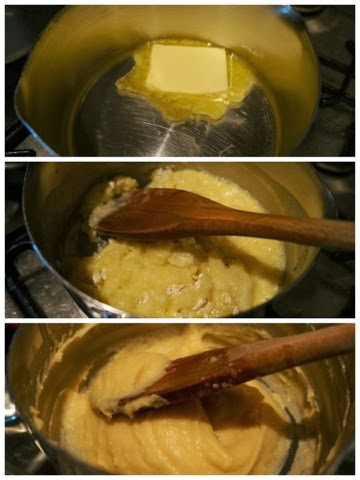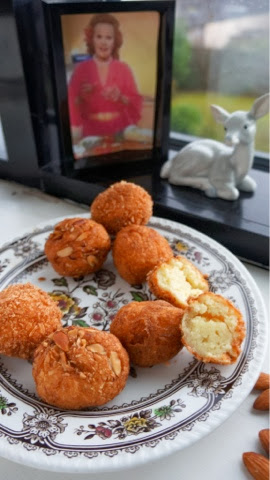No such trouble for me, just a quick trip to the local supermarket. Just as well, I couldn't be bothered with all that digging this weekend. Fanny is keen for me to learn the wonders of Potato Puffs, or Beignets or even Armandines - she can't quite make up her mind what the heck to call them. They sound perfect for this weekend though - a mixture of potato and her beloved choux paste, and then deep fried in balls.
Fanny gives the recipe for Choux paste twice on the same page, right next to one another - presumably because it SO important to her. So I take it very seriously, melting my butter gently in water then 'shooting' in the flour, mixing and allowing it to 'foam' in the pan a little. Off the heat, I beat and beat it before adding the eggs and beating again. Fanny absolutely insists that the mixture is left to get cold at room temperature with a plate over it before I go any further. Of course, I obey. Fanny says that on no account should I be tempted to refrigerate the mixture as it will ruin. It's fine Fanny, I'll take a seat and have a cup of tea.
Fanny gives three variations for these beignets, but they all start with steamed potatoes which are sieved and dried as before. Once the choux paste is cold, Fanny asks me to combine double the weight of sieved, stiff potato to make a paste. From the paste, walnut sized balls should be rolled. I leave a third of them as they are, roll a third in breadcrumbs (Fanny suggests very fine ones, but as always I feel the need to rebel a little so I use Panko) and the final third are rolled in finely chopped almonds. All that's left to do is fry them gently in some oil until they are golden brown. They all change to slightly different shades of golden, and the end result is fantastic. They are light and puffy, tasty and crisp. The almonds in particular add something really special. I made some French Onion Soup to have these perfectly puffed potatoes with - not slippery, not slimy, not discoloured and not rescued from deep within the garden...

























